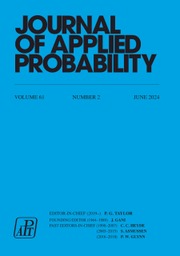Crossref Citations
This article has been cited by the following publications. This list is generated based on data provided by Crossref.
Rybarczyk, Katarzyna
2011.
Equivalence of a random intersection graph andG(n,p).
Random Structures & Algorithms,
Vol. 38,
Issue. 1-2,
p.
205.
Rybarczyk, Katarzyna
2011.
Diameter, connectivity, and phase transition of the uniform random intersection graph.
Discrete Mathematics,
Vol. 311,
Issue. 17,
p.
1998.
Bloznelis, Mindaugas
and
Radavičius, Irmantas
2011.
A note on Hamiltonicity of uniform random intersection graphs.
Lithuanian Mathematical Journal,
Vol. 51,
Issue. 2,
p.
155.
Bloznelis, Mindaugas
Godehardt, Erhard
Jaworski, Jerzy
Kurauskas, Valentas
and
Rybarczyk, Katarzyna
2015.
Data Science, Learning by Latent Structures, and Knowledge Discovery.
p.
79.
Rybarczyk, Katarzyna
and
Stark, Dudley
2017.
Poisson approximation of counts of induced subgraphs in random intersection graphs.
Discrete Mathematics,
Vol. 340,
Issue. 9,
p.
2183.
Bloznelis, Mindaugas
and
Jaworski, Jerzy
2018.
Algorithms and Models for the Web Graph.
Vol. 10836,
Issue. ,
p.
16.
Dong, Liang
and
Hu, Zhishui
2023.
The Number of Triangles in Random Intersection Graphs.
Communications in Mathematics and Statistics,
Vol. 11,
Issue. 4,
p.
695.
Gröhn, Tommi
Karjalainen, Joona
and
Leskelä, Lasse
2024.
Clique and cycle frequencies in a sparse random graph model with overlapping communities.
Stochastic Models,
Vol. 40,
Issue. 4,
p.
634.

